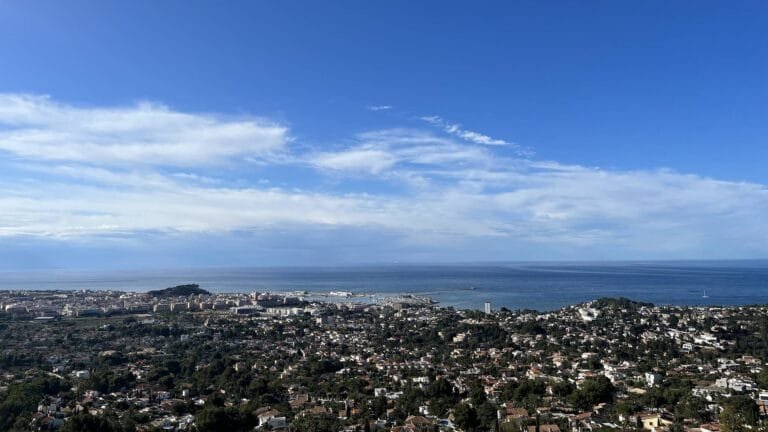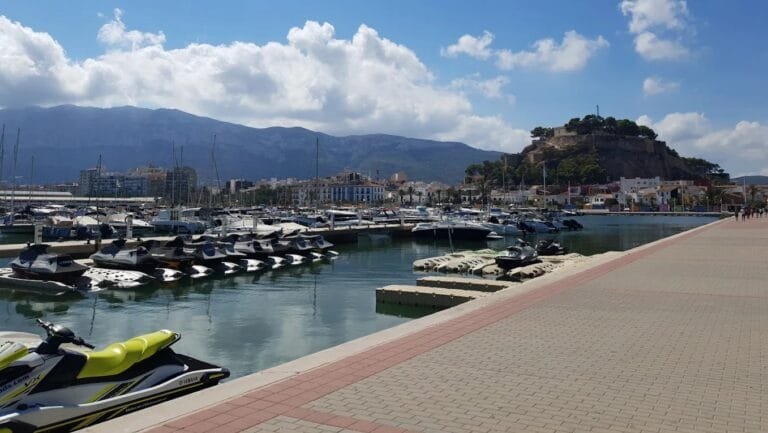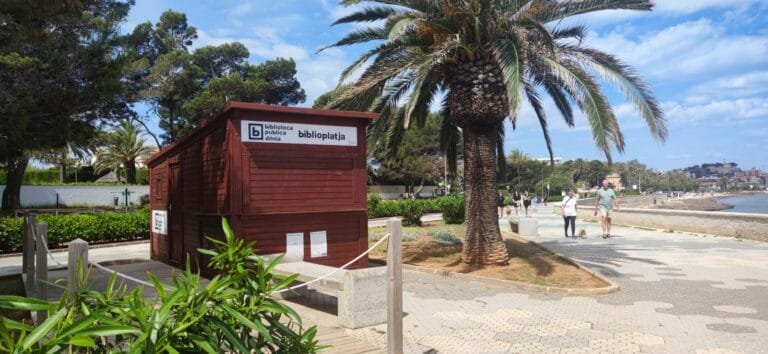
The Mediterranean is a paradise for sea lovers, but every summer, some unexpected visitors raise questions and concern: jellyfish. These creatures, fascinating as they are, can cause discomfort to swimmers if they are not well known.
If you plan to enjoy the beaches of Dénia, it’s important to know which jellyfish you might encounter, which are harmless, and which you should avoid. Here, we explain everything!
- Why Are There Jellyfish in Dénia and When Are They Most Common?
- 1. Rizostoma pulmo: The Harmless Giant
- 2. Cotylorhiza tuberculata: The "Fried Egg" Jellyfish
- 3. Pelagia noctiluca: The Jellyfish to Avoid
- 4. Velella velella: The "False Jellyfish" with a Sail
- Physalia physalis known as the Portuguese Man O’ War: A Very Rare Visitor
- Apps to Check Where Jellyfish Are in Dénia
- Share this Article and Keep Exploring Dénia!
Why Are There Jellyfish in Dénia and When Are They Most Common?
Jellyfish are not in the sea by chance; they are among the oldest living beings on the planet, and their presence has increased in recent years due to several factors:
✔️ Global warming: The rising temperature of the Mediterranean Sea is creating more favourable conditions for jellyfish proliferation. Milder winters and marine heatwaves allow these species to survive and multiply more easily.
✔️ Water temperature: In summer, warm currents bring jellyfish closer to the coast.
✔️ Lack of predators: The decline of sea turtles and sunfish, which feed on jellyfish, has encouraged their growth.
✔️ Marine currents and wind: On calm days or with easterly winds, jellyfish are more commonly seen floating near the shore.
If you want to avoid these encounters, always check the warning flags on the beach and avoid swimming after several days of calm seas.
The 4 Most Common Jellyfish in Dénia and Their Characteristics
1. Rizostoma pulmo: The Harmless Giant

Commonly called sea lung, this is the largest jellyfish you can find in our waters. Its appearance is unmistakable: a spherical white body with a lobed purple-edged rim.
🔹 Size: Up to 60 cm in diameter.
🔹 Danger: None. It does not sting.
🔹 Fun fact: Despite its large size, its tentacles pose no risk to swimmers.
👉 Tip: Do not remove them from the water. Even when dead, they can release toxins that cause mild irritation, but in the sea, they play an important ecological role.
2. Cotylorhiza tuberculata: The “Fried Egg” Jellyfish

Its popular name comes from its peculiar appearance: it has a body with a yellowish bump in the centre, resembling a fried egg floating in the water.
🔹 Size: 20-30 cm in diameter.
🔹 Danger: None. Its stinging cells are weak for humans.
🔹 Fun fact: Many divers gently touch them without any reaction.
👉 Tip: If you spot a group of these jellyfish, don’t worry. They are completely harmless and a spectacular visual experience.
3. Pelagia noctiluca: The Jellyfish to Avoid

This is a truly dangerous jellyfish that frequents the beaches of Dénia. Its common names are luminous jellyfish or sea carnation.
🔹 Size: 10-20 cm in diameter, with tentacles up to 2 metres long.
🔹 Danger: High. Its sting is very painful and causes a burning sensation.
🔹 Fun fact: It glows in the dark thanks to its bioluminescent cells.
👉 Tip: If stung by a Pelagia noctiluca:
✔️ Do not rub the skin or use fresh water.
✔️ Rinse with sea water and apply ice wrapped in a cloth.
✔️ If the reaction is severe, seek medical attention.
4. Velella velella: The “False Jellyfish” with a Sail

Also called the “sail jellyfish”, it is not truly a jellyfish despite appearances. This floating hydrozoan appears in large groups on the sea surface and is harmless.
🔹 Size: Small, up to 10 cm.
🔹 Danger: None. It has no stinging cells.
🔹 Fun fact: It moves thanks to the wind, like a tiny natural boat.
👉 Tip: Do not confuse it with the Portuguese Man O’ War, which is indeed dangerous.
Physalia physalis known as the Portuguese Man O’ War: A Very Rare Visitor

Although rare in the Mediterranean, sometimes currents carry specimens to our coasts. Its sting is extremely painful and can even be fatal in some cases.
🔹 Size: Float up to 30 cm, tentacles several metres long.
🔹 Danger: Extremely high. Its venom affects the nervous system.
🔹 Fun fact: It is not a jellyfish, but a colony of organisms working together.
👉 Tip: If you see one, keep your distance and alert the authorities.
👉 Why is it appearing in the Mediterranean?
Traditionally, the Portuguese Man O’ War was an Atlantic Ocean species, but in recent years it has expanded its range. This summer, specimens have been spotted in the Basque Country, Cantabria, Asturias, and Galicia, as well as in the Mediterranean in areas like Torrevieja and Tarragona.
Experts warn that its arrival on our coasts is linked to global warming and rising sea temperatures, which has allowed it to reach new areas. Other environmental factors also influence its proliferation, raising alert along the entire Mediterranean coast.
Apps to Check Where Jellyfish Are in Dénia
If you want to avoid encounters with jellyfish during your visit to Dénia’s beaches, there are mobile apps that can help:
📌 MedusApp: Allows users to report jellyfish sightings in real time and check an updated map of sightings.
📌 Meduseo: An app with an interactive map showing where jellyfish swarms have been detected in the past hours.
Both apps are free and can be very useful for planning your beach day without surprises. Once at the beach, also pay attention to the flags posted by lifeguards, which indicate the presence of jellyfish.
Share this Article and Keep Exploring Dénia!
Jellyfish shouldn’t stop you from enjoying the Mediterranean. By knowing which species inhabit Dénia and how to act in case of a sting, you can swim safely and worry-free.
🔹 Did you find this information useful? Share it with your friends so they can enjoy the sea without worries.
🔹 Discover more about Dénia’s beaches and summer tips at PlayasDenia.es. See you at the shore!






